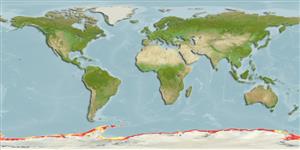>
Perciformes/Notothenioidei (Icefishes) >
Nototheniidae (Cod icefishes) > Trematominae
Etymology: Trematomus: Greek, trematos = hole + Greek, tomo = section, cut (Ref. 45335); scotti: Named after Captain Robert Falcon Scott, leader of British National Antarctic Expedition (Ref. 11892).
More on author: Boulenger.
Issue
The genus Pseudotrematomus is a synonym of Trematomus, which is confirmed by a molecular study to be published (J.-C. Hureau, pers. comm. 08 Jun. 2010).
Environment: milieu / climate zone / depth range / distribution range
Écologie
marin démersal; profondeur 20 - 793 m. Polar; 60°S - 78°S
Southern Ocean: South Shetland, South Orkney islands, Ross Sea, Breid Bay, Weddell Sea and Antarctic Peninsula (Ref. 11892).
Taille / Poids / Âge
Maturity: Lm ? range ? - ? cm
Max length : 24.7 cm TL mâle / non sexé; (Ref. 124149); poids max. publié: 124.60 g (Ref. 124149)
Adults feed primarily on polychaetes, euphausiids, amphipods, together with a lesser amount of isopods. Larval pelagic phase is long (Ref. 89434).
Life cycle and mating behavior
Maturities | Reproduction | Spawnings | Egg(s) | Fecundities | Larves
Dewitt, H.H., P.C. Heemstra and O. Gon, 1990. Nototheniidae. p. 279-331. In O. Gon and P.C. Heemstra (eds.) Fishes of the Southern Ocean. J.L.B. Smith Institute of Ichthyology, Grahamstown, South Africa. (Ref. 5179)
Statut dans la liste rouge de l'IUCN (Ref. 130435)
Menace pour l'homme
Harmless
Utilisations par l'homme
Pêcheries: sans intérêt
Outils
Articles particuliers
Télécharger en XML
Sources Internet
Estimates based on models
Preferred temperature (Ref.
123201): -1.8 - 0.9, mean -0.9 °C (based on 584 cells).
Phylogenetic diversity index (Ref.
82804): PD
50 = 0.5005 [Uniqueness, from 0.5 = low to 2.0 = high].
Bayesian length-weight: a=0.00479 (0.00320 - 0.00715), b=3.19 (3.07 - 3.31), in cm total length, based on LWR estimates for this species & Genus-body shape (Ref.
93245).
Niveau trophique (Ref.
69278): 3.2 ±0.2 se; based on diet studies.
Generation time: 11.0 ( na - na) years. Estimated as median ln(3)/K based on 1
growth studies.
Résilience (Ref.
120179): Très faible, temps minimum de doublement de population supérieur à 14 ans (Preliminary K or Fecundity.).
Fishing Vulnerability (Ref.
59153): High vulnerability (60 of 100).
Nutrients (Ref.
124155): Calcium = 39.9 [21.9, 100.2] mg/100g; Iron = 0.484 [0.206, 0.969] mg/100g; Protein = 17 [16, 18] %; Omega3 = 0.44 [0.23, 0.82] g/100g; Selenium = 13.6 [5.4, 30.8] μg/100g; VitaminA = 23.9 [5.1, 116.7] μg/100g; Zinc = 0.653 [0.422, 1.002] mg/100g (wet weight); based on
nutrient studies. 